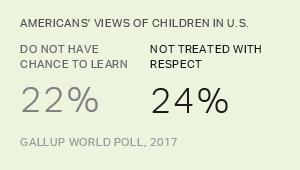Aug. 12 marks International Youth Day, which this year focuses on efforts to make education more relevant, equitable and inclusive for all the world's youth. This analysis is one of two that looks at how people around the world view opportunities for children in their countries to learn and grow.
The U.S. has deficits other than trade to worry about with China. Since the early days of the global economic crisis, China has led the U.S. by as much as 20 percentage points on Gallup's question of whether most children in their respective countries have the opportunity to learn and grow every day.
In 2018, 92% of Chinese adults said most children in their country have these types of opportunities, while 74% of U.S. adults said the same.
| Opportunity to learn and grow | |||||||||||||||||||||||||||||||||||||||||||||||||||||||||||||||||||||||||||||||||||||||||||||||||||
|---|---|---|---|---|---|---|---|---|---|---|---|---|---|---|---|---|---|---|---|---|---|---|---|---|---|---|---|---|---|---|---|---|---|---|---|---|---|---|---|---|---|---|---|---|---|---|---|---|---|---|---|---|---|---|---|---|---|---|---|---|---|---|---|---|---|---|---|---|---|---|---|---|---|---|---|---|---|---|---|---|---|---|---|---|---|---|---|---|---|---|---|---|---|---|---|---|---|---|---|
| % Yes | |||||||||||||||||||||||||||||||||||||||||||||||||||||||||||||||||||||||||||||||||||||||||||||||||||
| Switzerland | 96 | ||||||||||||||||||||||||||||||||||||||||||||||||||||||||||||||||||||||||||||||||||||||||||||||||||
| Indonesia | 94 | ||||||||||||||||||||||||||||||||||||||||||||||||||||||||||||||||||||||||||||||||||||||||||||||||||
| China | 92 | ||||||||||||||||||||||||||||||||||||||||||||||||||||||||||||||||||||||||||||||||||||||||||||||||||
| Australia | 90 | ||||||||||||||||||||||||||||||||||||||||||||||||||||||||||||||||||||||||||||||||||||||||||||||||||
| Canada | 89 | ||||||||||||||||||||||||||||||||||||||||||||||||||||||||||||||||||||||||||||||||||||||||||||||||||
| Netherlands | 87 | ||||||||||||||||||||||||||||||||||||||||||||||||||||||||||||||||||||||||||||||||||||||||||||||||||
| India | 86 | ||||||||||||||||||||||||||||||||||||||||||||||||||||||||||||||||||||||||||||||||||||||||||||||||||
| France | 86 | ||||||||||||||||||||||||||||||||||||||||||||||||||||||||||||||||||||||||||||||||||||||||||||||||||
| Japan | 85 | ||||||||||||||||||||||||||||||||||||||||||||||||||||||||||||||||||||||||||||||||||||||||||||||||||
| Spain | 84 | ||||||||||||||||||||||||||||||||||||||||||||||||||||||||||||||||||||||||||||||||||||||||||||||||||
| Saudi Arabia | 82 | ||||||||||||||||||||||||||||||||||||||||||||||||||||||||||||||||||||||||||||||||||||||||||||||||||
| United Kingdom | 81 | ||||||||||||||||||||||||||||||||||||||||||||||||||||||||||||||||||||||||||||||||||||||||||||||||||
| Germany | 80 | ||||||||||||||||||||||||||||||||||||||||||||||||||||||||||||||||||||||||||||||||||||||||||||||||||
| Italy | 76 | ||||||||||||||||||||||||||||||||||||||||||||||||||||||||||||||||||||||||||||||||||||||||||||||||||
| United States | 74 | ||||||||||||||||||||||||||||||||||||||||||||||||||||||||||||||||||||||||||||||||||||||||||||||||||
| South Korea | 68 | ||||||||||||||||||||||||||||||||||||||||||||||||||||||||||||||||||||||||||||||||||||||||||||||||||
| Mexico | 65 | ||||||||||||||||||||||||||||||||||||||||||||||||||||||||||||||||||||||||||||||||||||||||||||||||||
| Russia | 57 | ||||||||||||||||||||||||||||||||||||||||||||||||||||||||||||||||||||||||||||||||||||||||||||||||||
| Brazil | 48 | ||||||||||||||||||||||||||||||||||||||||||||||||||||||||||||||||||||||||||||||||||||||||||||||||||
| Turkey | 40 | ||||||||||||||||||||||||||||||||||||||||||||||||||||||||||||||||||||||||||||||||||||||||||||||||||
| Gallup World Poll, 2018 | |||||||||||||||||||||||||||||||||||||||||||||||||||||||||||||||||||||||||||||||||||||||||||||||||||
The two countries are the world's largest economies, but you wouldn't know that based on how people in each country answer this question.
Among 20 of the world's biggest economic players, the U.S. has the largest GDP, but it ranks 14th on that short list in terms of the opportunities Americans perceive for children in the U.S. China's overall GDP is second-largest in the world, but it ranks third on the opportunities that its adults see for children in China.
China's rising literacy rate -- which increased from 65.51% in 1982 to 96.36% in 2015 -- and its higher math and science scores than the U.S. on the OECD PISA (a global assessment of mathematics, reading and science skills) may lend support to why so many Chinese might see the situation so positively for their nation's children.
It might also help explain why Chinese adults are highly satisfied with the quality of the educational system or the schools where they live. In 2018, 70% -- a new high -- said they were satisfied with the quality of their local educational system, compared with 64% of Americans.
Education has been a strong lever for social mobility in modern China. Some of the optimism in China about children's opportunities may be related to the fact that the last two generations of Chinese (since the Reform and Opening Up policies in the late 1970s) have witnessed thousands of Chinese children from poor families use education to escape poverty and enjoy a middle class or better lifestyle.
Access to education in China has boomed. Estimates show that in 2017, 8 million students graduated from Chinese universities -- nearly 10 times the number 20 years ago and more than double the number at universities in the U.S.
Since the late 1990s, university admissions in China have increased at an average annual growth rate near 50% -- producing the largest infusion of highly educated workers in the labor market. By comparison, the number of Americans with college degrees has increased by about 20% since 2007.
While income inequality is an issue in each country, these differences don't show up in perceived opportunities for children. About seven in 10 Americans in the richest 20% of the population and seven in 10 in the poorest 20% say their children have the opportunity to learn and grow every day. In China, the richest 20% are only slightly more positive (92%) than the poorest (88%). But even the lowest-income Chinese are more likely than the highest-income Americans to see opportunities for children this way.
Final Thoughts
Relative to the Chinese, Americans are less likely to see opportunities for children in their country to learn and grow -- which may in turn raise more questions about how well U.S. children growing up today's economy are truly being prepared to compete in the global economy of tomorrow.
An educated and skilled labor force is the greatest asset a world power can have to ensure its long-term competitiveness. But maintaining an asset like this requires ongoing investment. In this regard, by the numbers and from the public's perspective, China continues to hold a competitive advantage.
Read more about Americans' views on the opportunities children in the U.S. have to learn and grow.



